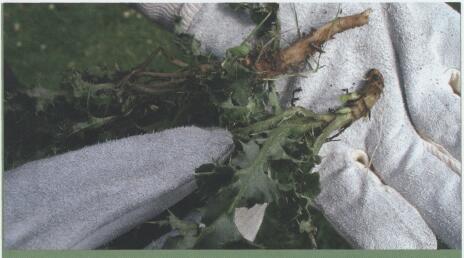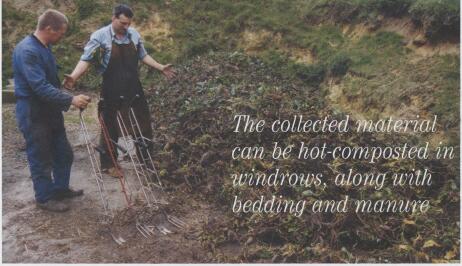The
Root of the Problem
Dr. John Zarb
Article from Organic Farming (Cover Story) Winter 2004 Issue 84
Return
to Publications Page | Page 1
| Page 2 | Page
3 | Page 4 |
parent stem
makes them less vulnerable to
further topping. You then have the makings
of a serious infestation. This could be a
good thing if you were prepared to harvest
and dry your thistles before grinding them
in a mill and feeding them to your goats.
Since creeping thistle thrives in moisture,
mole draining can also be an important
control measure.
further topping. You then have the makings
of a serious infestation. This could be a
good thing if you were prepared to harvest
and dry your thistles before grinding them
in a mill and feeding them to your goats.
Since creeping thistle thrives in moisture,
mole draining can also be an important
control measure.

Warning!
Hand pulling
is a vital aspect of weed
control. But pulling thousands of docks
which have grown from root segments as
a result of power harrowing, ploughing, or
rotovating is not recommended. If you are
forced to plough grassland before removing
docks, then at least attempt to remove them
and any root sections first before sowing.
Try the following approach:
control. But pulling thousands of docks
which have grown from root segments as
a result of power harrowing, ploughing, or
rotovating is not recommended. If you are
forced to plough grassland before removing
docks, then at least attempt to remove them
and any root sections first before sowing.
Try the following approach:
Straight after
ploughing use a spring-
tined or heavy drag harrow to break down
the furrows. Then start repeated dragging
with a five-framed chisel harrow to drag
docks into rows for collection, weighing
down each harrow frame. The latest folding
'Parmiter' harrow has slightly spaded chisel
points that are curved forwards to pull root
sections to the surface. Although these
harrows are generally used for pulling couch
into piles, they will also drag docks into
rows for collection. Subsequent dragging
with a chisel harrow is more effective after
the docks have produced some leaf which
makes them more easily caught by the
tines. Drag the roots towards the centre of
the worst infestations - in other words, do
not contaminate clean land. The collected
material can be hot-composted in windrows,
along with bedding and manure.
tined or heavy drag harrow to break down
the furrows. Then start repeated dragging
with a five-framed chisel harrow to drag
docks into rows for collection, weighing
down each harrow frame. The latest folding
'Parmiter' harrow has slightly spaded chisel
points that are curved forwards to pull root
sections to the surface. Although these
harrows are generally used for pulling couch
into piles, they will also drag docks into
rows for collection. Subsequent dragging
with a chisel harrow is more effective after
the docks have produced some leaf which
makes them more easily caught by the
tines. Drag the roots towards the centre of
the worst infestations - in other words, do
not contaminate clean land. The collected
material can be hot-composted in windrows,
along with bedding and manure.
If the problem
is really serious, then
a year of fallow followed by repeated
dragging is probably the best answer.
We are planning to attempt to lift docks
from cultivated land using an adapted
potato harvester.
a year of fallow followed by repeated
dragging is probably the best answer.
We are planning to attempt to lift docks
from cultivated land using an adapted
potato harvester.
And finally...
Apart from supplying
tools and training to
volunteer groups, farmers, conservation
organisations (such as English Nature and
the National Trust) and individuals with
weed problems, the Lazy Dog Tool Co is
also helping to raise local labour. From
time to time they can also supply teams
from home to carry out work on behalf of
landowners. Work for Swindon Borough
Council exemplifies the effectiveness of the
technique. Ten-year old docks at densities of
up to 15 plants per 25 square metres were
removed from 3.5ha of municipal parkland
- accompanied at one point by sneers of
derision - at a cost of £370/ha in 1999.
Light grazing with sheep was recommended
as a follow-up and subsequent site surveys
have revealed virtually complete eradication
of the dock problem.
volunteer groups, farmers, conservation
organisations (such as English Nature and
the National Trust) and individuals with
weed problems, the Lazy Dog Tool Co is
also helping to raise local labour. From
time to time they can also supply teams
from home to carry out work on behalf of
landowners. Work for Swindon Borough
Council exemplifies the effectiveness of the
technique. Ten-year old docks at densities of
up to 15 plants per 25 square metres were
removed from 3.5ha of municipal parkland
- accompanied at one point by sneers of
derision - at a cost of £370/ha in 1999.
Light grazing with sheep was recommended
as a follow-up and subsequent site surveys
have revealed virtually complete eradication
of the dock problem.
In 2003, Lazy
Dog Tool Co received
the bronze award in the Green Apple
Environmental Awards for Commerce
the bronze award in the Green Apple
Environmental Awards for Commerce
Water companies spend around
£120m a year
remove pesticides from our drinking water, yet
water-board tenants in major catchment areas
routinely spray docks and thistles
remove pesticides from our drinking water, yet
water-board tenants in major catchment areas
routinely spray docks and thistles

& Industry.
The company is currently
developing a number of initiatives,
including supporting weeding teams
in various parts of the country and
promoting the value of harvesting weeds
for composting. The tools themselves
are under continuous development, too.
Problems with the reliability of early forks,
with some breaking and some bending,
have now been completely solved with new
patterns and improved tempering.
developing a number of initiatives,
including supporting weeding teams
in various parts of the country and
promoting the value of harvesting weeds
for composting. The tools themselves
are under continuous development, too.
Problems with the reliability of early forks,
with some breaking and some bending,
have now been completely solved with new
patterns and improved tempering.
Not a panacea
No single sustainable
farming technique is
a panacea - its value depends on labour,
motivation, land use history, weather, soil,
external support, the integrated use of
other techniques, as well as many other
factors, and RIP weeding is no exception.
a panacea - its value depends on labour,
motivation, land use history, weather, soil,
external support, the integrated use of
other techniques, as well as many other
factors, and RIP weeding is no exception.
Research and
experience confirms
that weed removal using ergonomically
that weed removal using ergonomically
designed hand
tools can provide an
efficient, affordable and ecologically sound
approach to weed control in pasture,
arable, and conservation land. As well as
providing opportunities for employment,
the wider adoption of this approach would
reduce machinery and fuel dependence,
and keep us all in touch with our land.
efficient, affordable and ecologically sound
approach to weed control in pasture,
arable, and conservation land. As well as
providing opportunities for employment,
the wider adoption of this approach would
reduce machinery and fuel dependence,
and keep us all in touch with our land.
For more
information about the Lazy
Dog Tool range, the RIP technique, or
to view the full work rate predictor,
visit www.lazydogtoolco.co.uk. For
information on organic weed control
options visit www.organicweeds.org.uk
Dog Tool range, the RIP technique, or
to view the full work rate predictor,
visit www.lazydogtoolco.co.uk. For
information on organic weed control
options visit www.organicweeds.org.uk
Dr John Zarb
is an independent
researcher in sustainable farming, with
interests in urban farming, composting,
and soil microbiology-related issues.
Contact him on jzarb@pcxintemet.com
researcher in sustainable farming, with
interests in urban farming, composting,
and soil microbiology-related issues.
Contact him on jzarb@pcxintemet.com